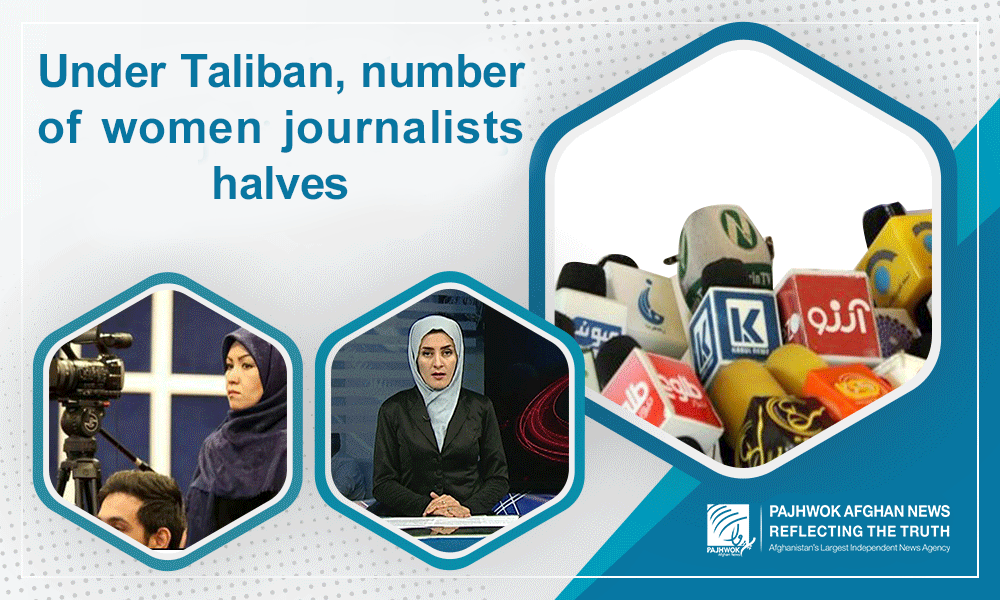KABUL (Pajhwok): Data from 15 media outlets suggests the number of women journalists associated with them has declined by 50 percent since last August.
Pajhwok Afghan News collected the data over the past 20 days from 15 print and electronic media outlets. The media outlets had not been pre-determined.
The data was obtained from Aryana TV, Zwandon TV, Tamadon TV, Aryana News, Aina TV, Arzo TV, Noor TV, China Centre, Rahi Farda TV, Ghazal TV, Aryana Radio, Sar Ahang, Ghazal, Daily Anis and Paik-i-Aftab News Agency.
Officials/workers of these news organisations provided this information over the telephone.
Media outlets downsized
According to the data, Peshgam and Rah-i-Farda TV channels carried out major downsizing of women staff members.
Earlier, 15 female staffers worked for Peshgam TV. Today, the TV channel has no female journalist.
Waheed Naweesa, assistant director of Peshgam TV News Department, said there were different reasons for the departure of female journalists.
Some families did not let their female members go out, he said, adding economic constraints after the fall of previous government was another reason.
Naweesa called cash issues one major issue and said: “Due to financial constraints, at this stage, we have no production and air old programmes.”
Small-scale job cuts
Daily Anis is one of the few media outlets that have seen no change. Earlier, two women worked for the newspaper and they are still there.
Ahmad Shakir Zarbi, editor-in-chief of the daily, said: “These two female staff members come to office once a week to mark their attendance.”
Daily Anis, Zarbi revealed, had been converted to a weekly because of financial problems. “Now the morninger is published on a weekly basis.”
He stressed the presence of female staffers in the media and said: “When a news outlet wants to file a report on a school or hospital for females. It needs a female staffer. This is also taught by the Sharia.”
Zahra Nawa, a reporter with Paik-i-Aftab New Agency, said media work had become even more critical for female staffers in a difficult environment.
Nawa complained this blatant injustice and discrimination towards female media employees was being seen under the present government.
She said Paik-i-Aftab News Agency started functioning after the takeover of the Islamic Emirate. Initially, 11 female employees worked for it but with the passage of five months, most female workers have quit their jobs due to restrictions and insecurity. Only four female employees are now working for it.
She believed: “The right of free speech taken away from people and they could not voice against injustice, tyranny and oppression the way they did in the past.”
About the arrest of Prof. Jalal, she said: “Now if someone talks against the system, they are detained.”
Nawa asked the caretaker government to respect the right of free speech and avoid snatching the right of access to information from journalists.
She urged government officials to allow female media staff members to work freely and disseminate facts to the masses.
Maryam Hotak, working for China Central TV and, complained access to information had been curtailed.
A few days back, when a press conference was held at the Ministry of Mining and Petroleum, she and two other women journalists were not allowed to cover the event.
Referring to the accident, she said: “When journalists are not allowed to cover a press conference, then how can we talk about access to information?”
She said discriminatory behaviour towards female journalists and curbs on access to information were some of the serious problems for them.
Alina Rasa, former reporter with Radio Gazal as reporter, recalled: “I worked with a media outlet that was led by a woman. Radio Gazal was shut down because it was run by a female. I as a reporter lost my job. At the moment, I am staying at home.”
She said six female journalists worked in Jawzjan earlier, but all of them quit their jobs after the Taliban’s takeover. Some journalists managed to flee and others resigned their jobs.
Farida Amina, who worked as a reporter for Bawar News Centre, is now living in Germany. She said: “At this time, even male journalists are not safe in Afghanistan. The safety of women journalists is hard to imagine.”
She said: “I am thinking about the safety or my fellow journalists in Afghanistan because I could understand in what condition they live and how they are dealing with the situation.”
Benafsha Naeemi, deputy director information for Badakhshan, said earlier 18 female journalists worked for different local media outlets in the province. But after the regime change, their number has come down.
She said: “Some female journalists in the province, sensing threats from the Islamic Emirate, stay home and don’t want to continue with their activities anymore.”
Media support organisations
Hujatullah Mujaddedi, executive director of the Free Journalists Association of Afghanistan, said the date collected by Reporters Without Boarders (RSF) and the Afghan Independent Journalists Association (AIJA) showed under the current government, more than 40 percent of media outlets had been shut and 80 percent of women journalists rendered jobless.
The closures of media outlets and decreasing activities have had a significant impact on the work of women journalists.
He said 410 female media workers were presently active, compared to 2,490 before the return of the current government. (Of every five women, four are unemployed).
Based on the data, there are no female journalists in 15 provinces of the country.
Dil Agha Qasimi, chief executive of the Afghan Media, said there was no doubt that the presence of female journalist had declined recently.
He cited security of journalists, especially females, the closure of media outlets due to lack of funds and the evacuation process as main reasons behind the falling number of women workers in media organisation.
Qasimi asked government and media officials to pay greater attention to the situation of women and ensure their security and privileges so that they could return to work.
He called on media support institutions to work for encouraging professional female journalists and the media sector from facing a shortage of women workers.
On the other hand, Amanullah Nusrat, head of the Afghanistan Free Radio and Television Coordination Centre, said recent developments had affected all institutions, including media. As a result, many journalists have lost their jobs.
“The decline in the number of female journalists would have a negative impact on our society,” he remarked.
Bilal Karimi, deputy spokesman for the caretaker government, said the Islamic Emirate had no role in shutting media organisations,
The media outlets, which were currently inactive, had been reliant on promoting foreign interests, the official claimed,
Female journalists were not allowed to cover the conference of the Ministry of Mines and Petroleum, he said: “There are exceptions. But in general, there is no problem with the work of media.
“All journalists, male or female, can continue to work in accordance with Islamic principles,” Karimi concluded.
nh/sa/mud
Views: 343









GET IN TOUCH
NEWSLETTER
SUGGEST A STORY
PAJHWOK MOBILE APP